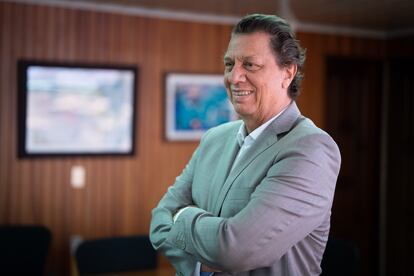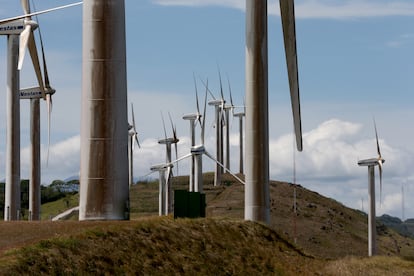EL PAÍS offers the América Futura section openly for its daily and global information contribution on sustainable development. If you want to support our journalism, subscribe here.
Costa Rica faces an almost existential dilemma faced with the desire to preserve the image of environmental exceptionality, the interest in capitalizing on that reputation, the desire to provide energy support to the accelerated growth of the economy and the temptation to go further towards the exploration of fossil fuels. , even with the possibility of taking the issue to a national referendum.
The doubt is not entirely new, but global trends, international discussion and internal political circumstances make it more explicit than ever for this small Central American country that is known to be applauded for its environmental commitment, but also examined in times of growing concern for climate change.
On the one hand, there are almost 50 years of an electricity generation network based on hydroelectric plants, plus secondary projects from alternative sources such as wind or geothermal. The tropical location and the high volumes of rain have made it possible to reach almost 100% clean electricity production in recent years, something that the authorities of the Government of Rodrigo Chaves still repeat although in this first quarter of 2024, 15% came from plants thermal plants supplied by petroleum derivatives, due to the reduction in rainfall caused by the weather phenomenon The boy.
On the other hand, there is the task of providing sufficient, affordable and stable energy to traditional industries and the latest technology, at a time when foreign investment is growing and the production of microprocessors is being promoted in the face of high interest from the United States. Modern factories cannot be turned off for even a minute.
Industrial growth compromises an energy model that, due to its base and scale, can be compared with Iceland (where geothermal energy predominates), New Zealand (which coincides in the weight of hydroelectric plants) or Uruguay, where there is now a strong push for wind energy, José Daniel Lara, a Costa Rican engineer based in the United States as a researcher at the National Renewable Energy Laboratory (NREL), in Colorado, explains to América Futura. In Costa Rica, two particularities are added: the forecast that demand will increase more than 10% by 2027, and the need to resolve the enormous dirty energy expenditure by the vehicle fleet that consumes derivatives of fossil fuels without there being a strategy to develop attractive public transport.
Costa Rica asks Norway for help
The problem was already raised, but in 2023 the Chaves Government stepped on a line that in Costa Rica was considered prohibited and, in fact, was prohibited by decrees of the last five administrations: the possibility of extracting the natural gas or oil that is supposed there may be in the Costa Rican subsoil. A Transport Minister said it first as if it were a personal idea, but soon the president took the floor and said that he had asked Norway for help to calculate the potential value of the supposed reserves, as a first step in making the decision to explore or No. His idea is to analyze whether exploitation is possible to generate wealth that turns Costa Rica into a rich country. “Be like Singapore,” said the president.
In a meeting in which the former Minister of the Environment and advisor to American oil companies Roberto Dobles participated, the Costa Rican authorities asked Norway for help due to the Nordic country’s experience in optimal use of its resources. Until now, Costa Rica purchases all already refined fuels through a state entity with a monopoly on import and distribution. But the Costa Rican Government has mentioned the possibility of building an oil refinery in the Caribbean and disassociated itself in December from the declaration of an international initiative signed by the previous Government to eradicate the extraction of oil and natural gas, called the Beyond Oil & Gas Alliance. (VOGUE).
The argument of the current authorities was that it was not realistic and that it hindered other agreements with the host of the 2023 United Nations Climate Change Conference (COP28), the United Arab Emirates, a nation with which Costa Rica has just signed the first trade agreement between that nation and a Latin American counterpart.

After seven months, Norway responded with a “no” that included a clear message: the Nordic country, which for 50 years enriched itself with its extractive industry, reported that it has already closed its international cooperation program on oil as part of a general internal strategy of economic diversification and progress towards alternative energies. “We know that the world is going to use less hydrocarbons in the future and the focus is to look for renewable energy sources that do not create emissions,” Norwegian ambassador Ragnhild Imerslund said during her visit.
“It is a very clear message for whoever wants to take it,” says researcher José Daniel Lara. “In Costa Rica, we do not know with certainty whether or not there are these resources. Assuming so, one must notice in an industry from scratch to be competitive. The truth is that we would be late to the party. It is like someone at 45 years old saying from one day to the next that they are going to run a marathon and win it,” adds Lara, knowing that the approach of the Costa Rican authorities contains a political element of promising wealth generation, especially in coastal regions. poor.
For this reason, President Chaves says that he will insist on seeking cooperation to evaluate the alleged reserves, but he has not said with which governments. There are studies from the 80s that even interested sectors consider not very useful. The pres
ident criticizes the “progressive” and “left” positions of prohibiting the extractive industry for ideological reasons and even refutes the argument that ecotourism must be protected, which contributes 8% of the GDP based on the country’s green image. “What argument would you make if natural gas were 200% of GDP per year? One has to be based on data, costs and benefits,” Chaves said.
The official position receives support from a sector of business associations, the national association of geologists and perhaps a considerable part of the population. In 2022, a survey by the University of Costa Rica (UCR) indicated that 48.5% of Costa Ricans approved of prohibiting oil exploration or exploitation by law and 45.6% preferred to leave the gate open. “Don’t you think we have to know how many resources there are for there to be a national discussion and a type of referendum?” Franz Tatternbach, Minister of Environment and Energy, said in an interview.

A bill seeks to stop oil exploitation
The discussion, however, goes beyond the Executive Branch, business associations and environmental groups. The Legislative Assembly is processing a bill contrary to the Government’s desire, as it seeks to establish by law the moratoriums on exploration that previous administrations have issued, via decree. The promoter of the legal reform is one of the eight pro-government legislators (among 57 seats) named Manuel Morales, convinced that the dangers and harms would be more than the benefits. There seems to be a good atmosphere to approve it; It has already passed a first filter in a commission on environmental issues where only one representative objected, arguing that in his region (Caribbean) natural conservation has not helped the population escape poverty. Morales, however, knows that, if his project is approved, President Chaves could veto it and then force a re-stamping with a qualified majority, but he returns to the issue of the Costa Rican image: “It would not be a very good signal for the Costa Government to give.” Rich compared to other countries,” said the congressman.
Researcher Lara, who participates in a solar energy planning project with the Costa Rican Institute of Electricity (ICE), prefers to distance himself from reasons of reputation and environmentalist invocations, although technical reasoning leads to the same conclusion: the country does not It is in your best interest to enter into a possible oil activity now that even the oil economies are seeking to diversify, such as Norway and those of the Arabian Peninsula. He understands that the motivations are economic and political, not so much energy security, but ultimately they are also related to local supply.

“Likewise, we must find a solution because Costa Rica has already saturated the potential of the hydroelectric source and this is combined with climatic situations and longevity of the system,” says Lara, critical of the way it has been planned in the past, without considering the years. of rainfall deficit as was 2023. In 2022, 67% of the generation came from hydroelectric plants, 14.7% from geothermal, 15% from wind and solar was insignificant. The contribution from imported petroleum derivatives plants was 1.7% that year, but for this first quarter of 2024 it multiplied by 10: 17%.
Now it is even less true that Costa Rica produces 100% of its energy with clean sources, as they say in the speeches, although that is still the goal. Therefore, for the next two years, ICE intends to invest almost $550 million in renewable projects in conjunction with private generation companies, the state agency announced in March. Planning is key, José Daniel Lara emphasizes in relation to a task that has not been done precisely in the past and in which he is now trying to collaborate to promote solar energy. “That was talked about 20 years ago, yes, but now the moment seems more decisive and there is no time to waste.”
#Costa #Ricas #existential #doubt #green #country #explore #fossil #fuels